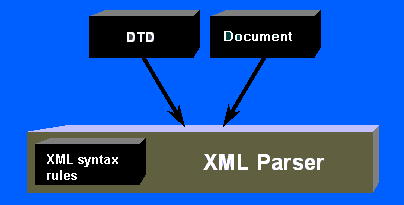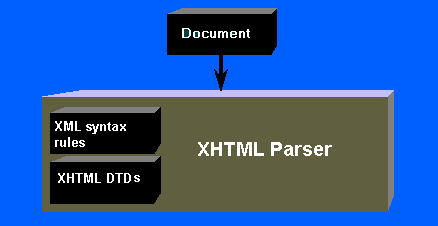Valid XML
- a valid document
- is well-formed and
- has been validated against a DTD (specified in the document - see later)

circle element must have an r (radius) attribute


<hr> must appear as <hr/>
(or <hr /> to fool old browsers)<!ELEMENT name (model) >where
ELEMENT is a keywordname is the element name
being declaredmodel is the element content model
(the allowed contents of the element)html element must contain a head element followed by
a body element:
<!ELEMENT html (head, body) >where "
," is the sequence (or concatenation) operator list element (not in HTML) must contain either a ul element or
an ol element (but not both):
<!ELEMENT list (ul|ol) >where "
|" is the alternation (or "exclusive or") operator ul element must contain zero or more li elements:
<!ELEMENT ul (li)* >where "
*" is the repetition (or "Kleene star") operator | DTD Syntax | Meaning |
|---|---|
b |
element b must occur |
b,c |
both b and
c must occur, in the order specified |
b|c |
one (and only one) of b or
c must occur |
b* |
zero or more occurrences of b must occur |
b+ |
one or more occurrences of b must occur |
b? |
zero or one occurrence of b must occur |
EMPTY |
no element content is allowed |
ANY |
any content (of declared elements and text) is allowed |
#PCDATA |
content is text rather than an element |
b
and c(a,b)*b+ is short for
(b,b*)b? is short for
(b|EMPTY)#PCDATA stands for "parsed character data", meaning an XML
parser should parse the characters to resolve character and entity references.
<!ELEMENT rss (channel) > <!ELEMENT channel (title,link,description,item+) > <!ELEMENT item (title,description,link,pubDate?) > <!ELEMENT title (#PCDATA) > <!ELEMENT link (#PCDATA) > <!ELEMENT description (#PCDATA) > <!ELEMENT pubDate (#PCDATA) >
rss-fragment-dtd-invalid.xml giving
results
rss-fragment-dtd-valid.xml giving
results
<!DOCTYPE rss ... ><?xml version="1.0"?> <!DOCTYPE rss [ <!-- all declarations for rss DTD go here --> ... <!ELEMENT rss ... > ... ]> <rss> <!-- This is an instance of a document of type rss --> ... </rss>
rss must be
defined in the DTDDOCTYPE (i.e.,
rss) must match root element
of document<?xml version="1.0"?> <!DOCTYPE rss SYSTEM "rss.dtd"> <rss> <!-- This is an instance of a document of type rss --> ... </rss>
SYSTEM is a URIrss.dtd is a relative URI, assumed to be in
same directory as source document
<?xml version="1.0"?>
<!DOCTYPE math PUBLIC "-//W3C//DTD MathML 2.0//EN"
"http://www.w3.org/TR/MathML2/dtd/mathml2.dtd">
<math>
<!-- This is an instance of a mathML document type -->
...
</math>
PUBLIC means what follows is a formal public
identifier with 4 fields:
ISO for ISO standard, + for approval by
other standards body, and - for everything elseW3CDTD MathML 2.0ENFormal public identifiers are meant for widely used entities. They should be unique world-wide. Processing software might either come with such entities already installed or it might know the most efficient sites form which to download them. If not, the URI is used to retrieve the DTD.
href="file.html" in an HTML a start tagrss and guid elements, these might be
<!ATTLIST rss version CDATA #FIXED "2.0" > <!ATTLIST guid isPermaLink (true|false) "true" >
versionCDATA"true"CDATA: any valid character dataID: an identifier unique within the documentIDREF: a reference to a unique identifierIDREFS: a reference to several unique identifiers
(separated by white-space)(a|b|c),
e.g.: (enumerated attribute type)
possible values are one of
a, b
or c#IMPLIED: attribute may be omitted (optional)#REQUIRED: attribute must be present#FIXED "x", e.g.:
attribute optional; if present, value
must be x"x", e.g.: value will be
x if attribute is omittedrss DTD all content models comprise only
elements or only textem, img, b, etc.em, img and
b as contents of element p:
<!ELEMENT p (#PCDATA | em | img | b)* >
#PCDATA must be first (in the definition)|* applied to them(zero, one)* and (zero | one)*.
Give an example of a sequence of elements allowed by the one model but not by the other.
day, month and year.
Produce a content model which allows for each of the sequences
year month year day month yearbut no others.
<!ELEMENT family (parent, (parent)?, (child)*)> <!ELEMENT parent (name)> <!ELEMENT child (name)> <!ELEMENT name (#PCDATA)> <!ATTLIST parent pno ID #IMPLIED role (mother|father) #IMPLIED spouse IDREF #IMPLIED> <!ATTLIST child cno ID #IMPLIED date-of-birth CDATA #IMPLIED siblings IDREFS #IMPLIED>
spouse attribute is meant to be interpreted as
a reference to a pno attributesiblings attribute is meant to be interpreted as
a set of references to cno attributes<?xml version="1.0"?> <!-- <!DOCTYPE family [ ... DTD goes here ... ]> --> <family> <parent pno="p1" role="mother" spouse="p2"> <name>Janet</name> </parent> <parent pno="p2" role="father" spouse="p1"> <name>John</name> </parent> <child cno="c1" siblings="c2 c3"> <name>Tom</name> </child> <child cno="c2" siblings="c1 c3"> <name>Dick</name> </child> <child cno="c3" siblings="c1 c2"> <name>Harry</name> </child> </family>
<?xml version="1.0"?>
<!-- <!DOCTYPE family [ ... DTD goes here ... ]> -->
<family>
<parent pno="janet">
<name>Janet</name>
</parent>
<child date-of-birth="yesterday">
<name>Tom</name>
</child>
</family>
ID to be referenceddate-of-birth cannot be restricted to a valid
date by a DTD
<family>
<parent role="stepmother" spouse="john jim">
<name>Janet</name>
</parent>
<parent pno="john" spouse="janet"></parent>
<parent pno="jim" spouse="janet"></parent>
</family>
role is given, must be mother
or fatherspouse must refer to only one value of type
IDspouse must refer to a value of type ID
which existsparent must have a nameparent elements allowedinvalid-family.xml
using the online XML validator gives
results
<!ENTITY BBK "Birkbeck, University of London">&BBK;
substitutes value of entity for its name in documentxmas.xml can be
produced by<!DOCTYPE xmas [ <!ENTITY on "On the"> <!ENTITY day "day of Christmas my true love sent to me"> <!ENTITY partridge "<line>a partridge in a pear tree.</line>"> <!ENTITY doves "<line>two turtle doves and</line> &partridge;"> <!ENTITY hens "<line>three French hens,</line> &doves;"> <!ELEMENT xmas (verse+)> <!ELEMENT verse (line+)> <!ELEMENT line (#PCDATA)> ]> <xmas> <verse><line>&on; first &day;</line> &partridge;</verse> <verse><line>&on; second &day;</line> &doves;</verse> <verse><line>&on; third &day;</line> &hens;</verse> </xmas>
BBK is an example of a general entity& (&),
< (<), >
(>), " ("),
' ('),<!ENTITY HTML-chapter SYSTEM "html.xml" >
&HTML-chapter; includes contents of file
html.xml at point of referencestandalone="no" in XML declaration% between
ENTITY and name, e.g.,
<!ENTITY % list "OL | UL" > <!ENTITY % heading "H1 | H2 | H3 | H4 | H5 | H6" >
% and ; delimiters,
e.g.,
<!ENTITY % block "P | %list; | %heading; | ..." >
& operator from SGML)exam. An exam has a
course code, a title and a
date, which comprises only the month
and year. These are followed by a list of
questions. Exams consist of either 5 or 6 questions.
Each question has one or more parts.
Parts of questions can themselves comprise parts
along with text.
programme. A
programme has a degree and a year.
These elements are followed by the
results for the programme. The results
are partitioned into distinction, merit,
pass and fail. Within each is a sequence of
name elements, each containing the name of a person
having achieved the corresponding result for the
programme.teaches with attributes course and
lecturer, representing the relationship
between courses taught on an MSc programme and the lecturers who
teach them. Give an XML DTD for representing this information.www.w3.org/TR/REC-xml.htmlwww.w3schools.com/dtdvalidator.w3.orgen.wikipedia.org/wiki/Chomsky_hierarchyDTDs are covered in Chapter 4 of [Moller and Schwartzbach] and briefly in Chapter 2 of [Jacobs].